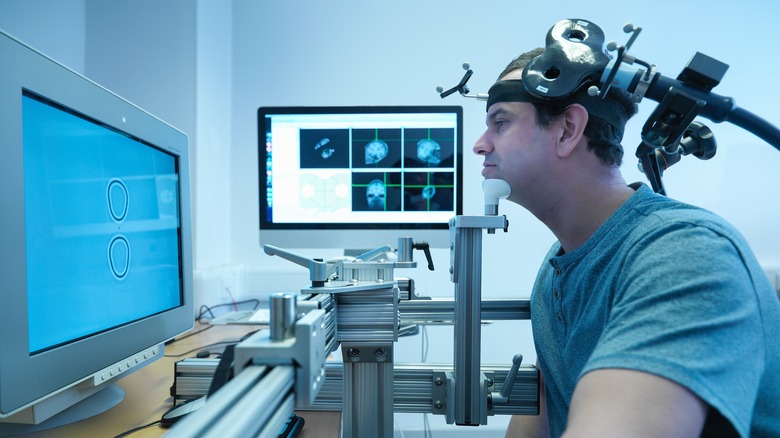The World Health Organization estimates that around 5% of adults worldwide suffer from depression. Symptoms of depression can include poor concentration, hopelessness, disrupted sleep, or low energy for at least two weeks. People with depression can find relief through therapy or taking antidepressant medication. UC San Diego Health says that some people have treatment-resistant depression, which occurs when two different antidepressants are ineffective in managing your depression. For these people with severe depression, there are several procedures that can help.
According to Harvard Medical School, electroconvulsive therapy (ECT), also known as “shock therapy,” has for many years the most effective treatment for people with treatment-resistant depression. The procedure, which is performed with the patient under general anesthesia, triggers a seizure by sending electrical currents through the brain (via Mayo Clinic). ECT typically requires a few treatments a week for three to four weeks, and the side effects include confusion and memory loss.
Transcranial magnetic stimulation (TMS) is a newer form of brain stimulation that’s noninvasive (per Harvard Medical School). Unlike ECT, TMS doesn’t require general anesthesia, and the TMS device works outside the body to stimulate parts of the brain that affect depression. It’s provided relief for more than half of people who suffer from treatment-resistant depression, and one-third of people experience complete remission from their depression.
How TMS works

TMS works using magnets and electricity, according to the Cleveland Clinic. Because your brain is sending out electric signals throughout your body at every moment of your day, TMS uses a magnet to guide some of these signals in certain parts of your brain. Don’t worry — getting too close to a refrigerator magnet won’t disrupt your brain activity. TMS methods can vary depending on the strength of the magnet, the number and patterns of pulses, and the type of magnetic coil.
During the TMS procedure, you’ll need to remove any jewelry or anything with metal. TMS doesn’t need an operating room — you’ll sit in a special type of chair while you’re awake. The device is rather loud, so you’ll be given earphones or another device to protect your hearing.
You’ll either wear a helmet that houses the magnet, or the TMS provider will position the magnet near a specific part of your head, depending on your specific condition. Then, the TMS will send electrical pulses that might feel like tapping. Here’s where your fingers will twitch. This tapping will increase until the right pulse strength is found. The TMS procedure will deliver the specific patterns and strength of pulses, and can last up to 50 minutes. You can then go about the rest of your day. TMS could require up to six treatments, although you might notice the benefits after one treatment, according to Harvard Medical School.
TMS side effects and how it can help with other conditions

As with any procedure, TMS can have some side effects. People undergoing TMS treatment could experience headache, lightheadedness, scalp discomfort, or facial twitching, according to the Mayo Clinic. In rare cases, some people could experience seizures or hearing loss if their ears weren’t protected during the procedure. People with bipolar disorder might experience mania.
The U.S. Food & Drug Administration (FDA) has approved TMS for treatment-resistant depression, obsessive-compulsive disorder (OCD), and certain types of migraine. TMS could also help with post-traumatic stress disorder (PTSD), Tourette syndrome, chronic pain, generalized anxiety disorder, and some movement disorders such as Parkinson’s disease (via Repetitive Transcranial Magnetic Stimulation). According to a 2024 article in Dialogues in Clinical Neuroscience, TMS could help people rehabilitate their motor functions after suffering from stroke. It also could be useful to stimulate the areas in the brain related to cognitive decline in older adults, particularly in people with Alzheimer’s or other types of dementia.




